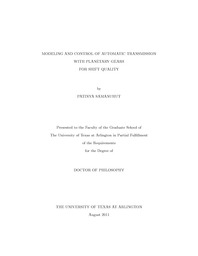
ATTENTION: The works hosted here are being migrated to a new repository that will consolidate resources, improve discoverability, and better show UTA's research impact on the global community. We will update authors as the migration progresses. Please see MavMatrix for more information.
Show simple item record
| dc.contributor.author | Samanuhut, Patinya | en_US |
| dc.date.accessioned | 2011-10-11T20:49:04Z | |
| dc.date.available | 2011-10-11T20:49:04Z | |
| dc.date.issued | 2011-10-11 | |
| dc.date.submitted | January 2011 | en_US |
| dc.identifier.other | DISS-11151 | en_US |
| dc.identifier.uri | http://hdl.handle.net/10106/6191 | |
| dc.description.abstract | Automatic transmission is a major component in a vehicle that transmits the power source from the engine to the drive wheels of the vehicle. To improve fuel economy, reduce emission and enhance driving performance, many researchers have made tremendous efforts on new technologies for automatic transmission with planetary gear sets. Among these new technologies, system dynamics and control methodologies are extremely important tools to realizing the fuel economy, emission and driving performance. This research effort focuses on the modeling and control of an automatic transmission with planetary gear sets. A Lagrange-based method is developed to derive the equations of motion of planetary gear sets and applied to the development of a mathematical model for the automatic transmission GM Hydramatic 440. The other transmission subsystems such as torque converter, hydraulic system, friction elements and final drive are modeled based on the methods available in the open literature. Additionally, simple engine and vehicle models are included as the main focus of the research is on the transmission. Since the model of friction used in clutches and bands are very important for studying shift quality, an improved friction model based on three modes is used. The hydraulic system is given particular attention as it is the primary source of actuation in performing shifts. The second part of the research focuses on developing feedback control mechanisms for improving shift quality. The implementation of feedback control helps avoid tedious process of pressure profile calibration to obtain satisfactory shift quality. Further, it provides a level of robustness in shift quality against the variation of vehicle properties and the changes in driving condition. One nonlinear and one linear feedback control design methods are implemented. The sliding mode control method is the nonlinear control approach. The implementation of this controller requires the knowledge of the clutch/band torque, which is not practical to measure. To overcome this difficulty, various observer solutions are investigated. Despite the difficulty in its implementation, the sliding mode controller is still useful to obtain required speed profiles for a satisfactory shift quality. As the linear feedback controller, the PID control design is employed. For each up and down shifts, a PID controller is tuned to generate the applied friction profile for the friction element involved. For the calculation of the error signal as the input to each PID controller, the most relevant speed measurements are used for feedback and the desired speed command is determined based on the status of the rotating elements in the desired gear. Despite its simplicity and ease of its implementation, the speed-measurement-based PID controllers are shown to provide satisfactory shift quality in terms of reduced jerk experienced during the shift and shorter duration of the shift. Further, a Monte Carlos analysis has shown the robustness of the PID controller against the model variation, specifically variation of the parameters in friction model. | en_US |
| dc.description.sponsorship | Dogan, Atilla | en_US |
| dc.language.iso | en | en_US |
| dc.publisher | Mechanical Engineering | en_US |
| dc.title | Modeling And Control Of Automatic Transmission With Planetary Gears For Shift Quality | en_US |
| dc.type | Ph.D. | en_US |
| dc.contributor.committeeChair | Dogan, Atilla | en_US |
| dc.degree.department | Mechanical Engineering | en_US |
| dc.degree.discipline | Mechanical Engineering | en_US |
| dc.degree.grantor | University of Texas at Arlington | en_US |
| dc.degree.level | doctoral | en_US |
| dc.degree.name | Ph.D. | en_US |
Files in this item
- Name:
- Samanuhut_uta_2502D_11151.pdf
- Size:
- 4.656Mb
- Format:
- PDF
This item appears in the following Collection(s)
Show simple item record


